the rhythm of peotry(for lecture)
- 格式:ppt
- 大小:287.00 KB
- 文档页数:29
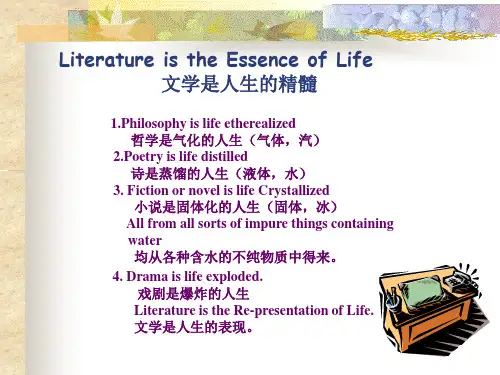
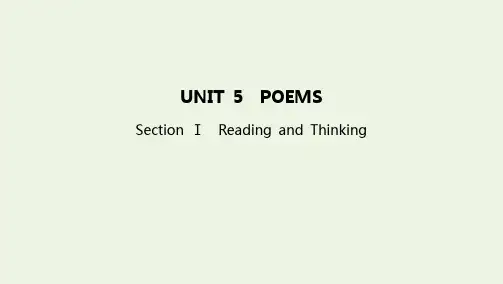
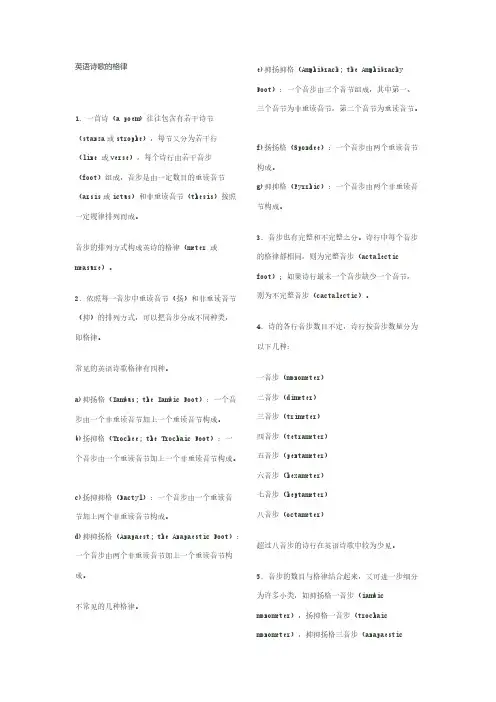
英语诗歌的格律1.一首诗(a poem)往往包含有若干诗节(stanza或strophe),每节又分为若干行(line 或verse),每个诗行由若干音步(foot)组成,音步是由一定数目的重读音节(arsis或ictus)和非重读音节(thesis)按照一定规律排列而成。
音步的排列方式构成英诗的格律(meter 或measure)。
2.依照每一音步中重读音节(扬)和非重读音节(抑)的排列方式,可以把音步分成不同种类,即格律。
常见的英语诗歌格律有四种。
a)抑扬格(Iambus; the Iambic Foot):一个音步由一个非重读音节加上一个重读音节构成。
b)扬抑格(Trochee; the Trochaic Foot):一个音步由一个重读音节加上一个非重读音节构成。
c)扬抑抑格(Dactyl):一个音步由一个重读音节加上两个非重读音节构成。
d)抑抑扬格(Anapaest; the Anapaestic Foot):一个音步由两个非重读音节加上一个重读音节构成。
不常见的几种格律。
e)抑扬抑格(Amphibrach; the Amphibrachy Foot):一个音步由三个音节组成,其中第一、三个音节为非重读音节,第二个音节为重读音节。
f)扬扬格(Spondee):一个音步由两个重读音节构成。
g)抑抑格(Pyrrhic):一个音步由两个非重读音节构成。
3.音步也有完整和不完整之分。
诗行中每个音步的格律都相同,则为完整音步(actalectic foot);如果诗行最末一个音步缺少一个音节,则为不完整音步(cactalectic)。
4.诗的各行音步数目不定,诗行按音步数量分为以下几种:一音步(monometer)二音步(dimeter)三音步(trimeter)四音步(tetrameter)五音步(pentameter)六音步(hexameter)七音步(heptameter)八音步(octameter)超过八音步的诗行在英语诗歌中较为少见。
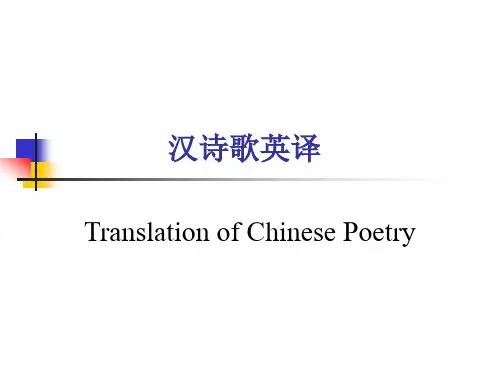
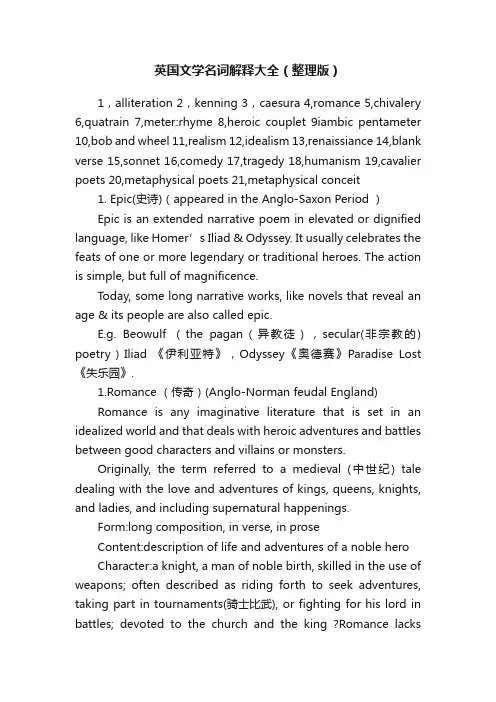
英国文学名词解释大全(整理版)1,alliteration 2,kenning 3,caesura 4,romance 5,chivalery 6,quatrain 7,meter:rhyme 8,heroic couplet 9iambic pentameter 10,bob and wheel 11,realism 12,idealism 13,renaissiance 14,blank verse 15,sonnet 16,comedy 17,tragedy 18,humanism 19,cavalier poets 20,metaphysical poets 21,metaphysical conceit1. Epic(史诗)(appeared in the Anglo-Saxon Period )Epic is an extended narrative poem in elevated or dignified language, like Homer’s Iliad & Odyssey. It usually celebrates the feats of one or more legendary or traditional heroes. The action is simple, but full of magnificence.Today, some long narrative works, like novels that reveal an age & its people are also called epic.E.g. Beowulf (the pagan(异教徒),secular(非宗教的) poetry)Iliad 《伊利亚特》,Odyssey《奥德赛》Paradise Lost 《失乐园》.1.Romance (传奇)(Anglo-Norman feudal England)Romance is any imaginative literature that is set in an idealized world and that deals with heroic adventures and battles between good characters and villains or monsters.Originally, the term referred to a medieval (中世纪) tale dealing with the love and adventures of kings, queens, knights, and ladies, and including supernatural happenings.Form:long composition, in verse, in proseContent:description of life and adventures of a noble hero Character:a knight, a man of noble birth, skilled in the use of weapons; often described as riding forth to seek adventures, taking part in tournaments(骑士比武), or fighting for his lord in battles; devoted to the church and the king ?Romance lacksgeneral resemblance to truth or reality.It exaggerates the vices of human nature and idealizes the virtues.It contains perilous (dangerous) adventures more or less remote from ordinary life.It lays emphasis on supreme devotion to a fair lady.3. Alliteration(押头韵): a repeated initial(开头的) consonant(协调,一致) to successive(连续的) words.4. Heroic couplet (英雄双韵体)(introduced by Geoffrey Chaucer)Definition:the rhymed couplet of iambic pentameter; a verse form in epic poetry, with lines of ten syllables and five stresses, in rhyming pairs.英雄诗体/英雄双韵体:用于史诗或叙事诗,每行十个音节,五个音部,每两行押韵。
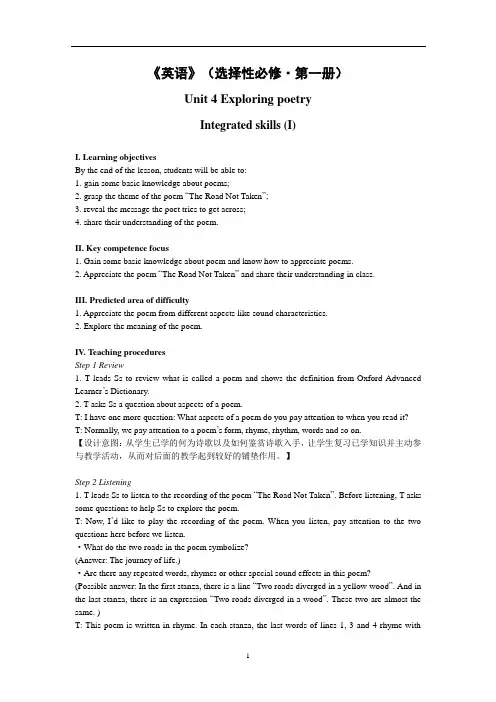
《英语》(选择性必修·第一册)Unit 4 Exploring poetryIntegrated skills (I)I. Learning objectivesBy the end of the lesson, students will be able to:1.gain some basic knowledge about poems;2. grasp the theme of the poem “The Road Not Taken”;3. reveal the message the poet tries to get across;4. share their understanding of the poem.II. Key competence focus1. Gain some basic knowledge about poem and know how to appreciate poems.2. Appreciate the poem “The Road Not Taken” and share their understanding in class.III. Predicted area of difficulty1. Appreciate the poem from different aspects like sound characteristics.2. Explore the meaning of the poem.IV. Teaching proceduresStep 1 Review1. T leads Ss to review what is called a poem and shows the definition from Oxford Advanced Learner’s Dictionary.2. T asks Ss a question about aspects of a poem.T: I have one more question: What aspects of a poem do you pay attention to when you read it? T: Normally, we pay attention to a poem’s form, rhyme, rhythm, words and so on.【设计意图:从学生已学的何为诗歌以及如何鉴赏诗歌入手,让学生复习已学知识并主动参与教学活动,从而对后面的教学起到较好的铺垫作用。
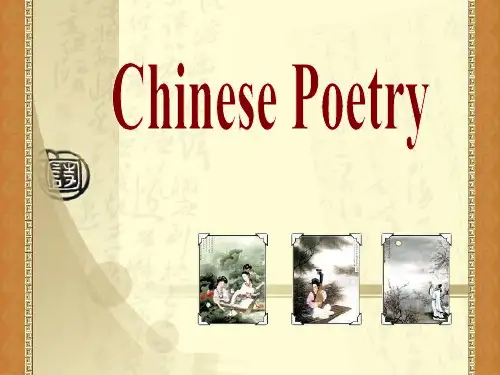
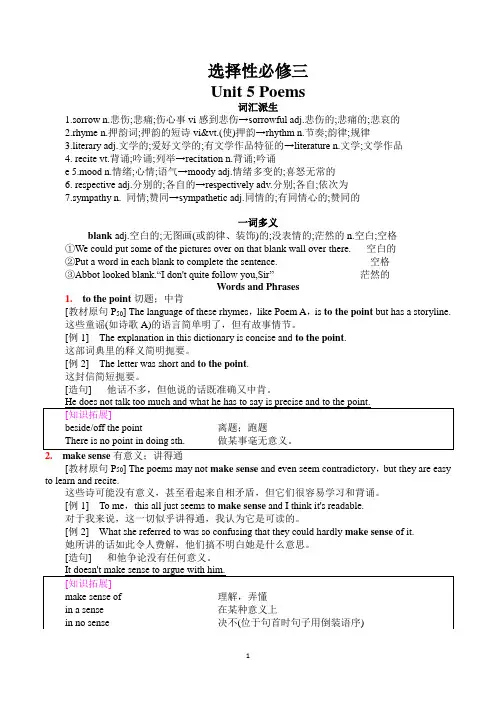
选择性必修三Unit 5 Poems词汇派生1.sorrow n.悲伤;悲痛;伤心事vi感到悲伤→sorrowful adj.悲伤的;悲痛的;悲哀的2.rhyme n.押韵词;押韵的短诗vi&vt.(使)押韵→rhythm n.节奏;韵律;规律3.literary adj.文学的;爱好文学的;有文学作品特征的→literature n.文学;文学作品4. recite vt.背诵;吟诵;列举→recitation n.背诵;吟诵e 5.mood n.情绪;心情;语气→moody adj.情绪多变的;喜怒无常的6. respective adj.分别的;各自的→respectively adv.分别;各自;依次为7.sympathy n. 同情;赞同→sympatheti c adj.同情的;有同情心的;赞同的一词多义blank adj.空白的;无图画(或韵律、装饰)的;没表情的;茫然的n.空白;空格①We could put some of the pictures over on that blank wall over there. 空白的②Put a word in each blank to complete the sentence. 空格③Abbot looked blank.“I don't quite follow you,Sir”茫然的Words and Phrases1.to the point切题;中肯[教材原句P50] The language of these rhymes,like Poem A,is to the point but has a storyline.这些童谣(如诗歌A)的语言简单明了,但有故事情节。
[例1]The explanation in this dictionary is concise and to the point.这部词典里的释义简明扼要。
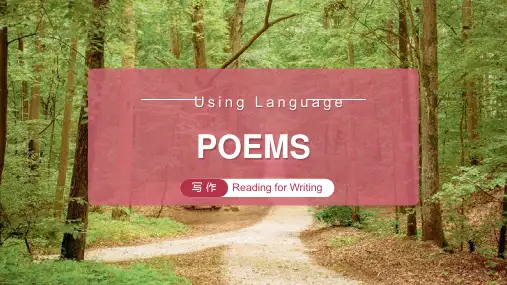
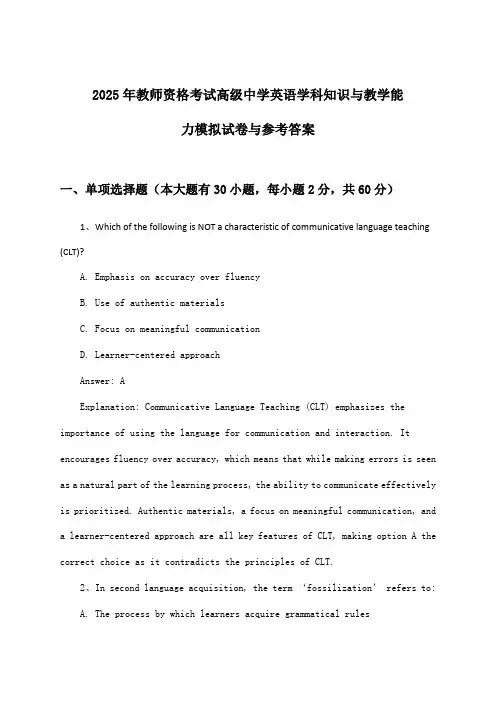
2025年教师资格考试高级中学英语学科知识与教学能力模拟试卷与参考答案一、单项选择题(本大题有30小题,每小题2分,共60分)1、Which of the following is NOT a characteristic of communicative language teaching (CLT)?A. Emphasis on accuracy over fluencyB. Use of authentic materialsC. Focus on meaningful communicationD. Learner-centered approachAnswer: AExplanation: Communicative Language Teaching (CLT) emphasizes the importance of using the language for communication and interaction. It encourages fluency over accuracy, which means that while making errors is seen as a natural part of the learning process, the ability to communicate effectively is prioritized. Authentic materials, a focus on meaningful communication, and a learner-centered approach are all key features of CLT, making option A the correct choice as it contradicts the principles of CLT.2、In second language acquisition, the term ‘fossilization’ refers to:A. The process by which learners acquire grammatical rulesB. The point at which a learner’s interlanguage stops developingC. The initial stage of language learning where vocabulary is emphasizedD. The technique of using physical objects to teach language conceptsAnswer: BExplanation: Fossilization is a phenomenon in second language acquisition where the errors made by learners become permanent and resistant to change. This typically occurs when a learner reaches an intermediate level but fails to progress further, resulting in a stabilization of their interlanguage, which is the learner’s current state of knowled ge about the target language. Options A, C, and D do not accurately describe fossilization, thus B is the correct answer.3、The teacher is about to introduce a new topic in the English class. Which of the following phrases can best be used to engage the st udents’ interest and prepare them for the lesson?A. “Now, class, let’s dive into the depths of this new topic.”B. “Alright, everyone, it’s time to turn the page and explore something new.”C. “Today, we’re going to embark on an adventure through the worl d of literature.”D. “Let’s start by reviewing what we learned last class, and then we’ll move on to our new topic.”Answer: C. “Today, we’re going to embark on an adventure through the worldof literature.”Explanation: Option C uses an engaging and vivid phrase (“embark on an adventure”) that can capture the students’ interest and create a sense of excitement about the new topic. It also clearly indicates the direction of the lesson, which is beneficial for setting expectations and preparing the students for what to expect.4、In a reading comprehension activity, the teacher wants to ensure that students understand the main idea of a passage. Which of the following methods is most effective for this purpose?A. “Find the first sentence of each paragraph and summarize it.”B. “Circle the keywords in each paragraph and then discuss their meaning.”C. “Read the passage aloud and pause after each paragraph to discuss the main point.”D. “Write a one-sentence summary of the entire passage and share it with the cl ass.”Answer: D. “Write a one-sentence summary of the entire passage and share it with the class.”Explanation: Option D encourages students to think critically about the passage and distill its main idea into a concise statement. This method promotes active engagement with the text and helps students internalize the key information. It also allows the teacher to monitor each student’s understanding and provide feedback accordingly.5、Which of the following teaching methods emphasizes student-centered learning and encourages active engagement in the classroom?A、Lecture methodB、Auditory methodC、Interactive methodD、Cooperative methodAnswer: CAnalysis: The interactive method (选项C) is a student-centered approach that encourages active participation and interaction among students. This method promotes collaborative learning and discussion, which helps students develop critical thinking and communication skills.6、In the context of English language teaching, which of the following activities is most suitable for achieving the communicative competence of advanced high school students?A、Translating short paragraphs from English to ChineseB、Listening to and discussing authentic English-language podcastsC、Writing detailed summaries of poetryD、Parroting back English-language vocabulary listsAnswer: BAnalysis: Listening to and discussing authentic English-language podcasts (选项B) is the most suitable activity for achieving the communicative competence of advanced high school students. This activity provides real-worldlanguage input and encourages students to engage in meaningful communication, understand cultural nuances, and practice comprehension in an authentic context.7、The teacher is demonstrating a new vocabulary word to the high school students. Which of the following techniques would be most effective in helping the students retain the information?A. Using a direct translation from a familiar language.B. Providing a visual representation of the word in context.C. Asking students to repeat the word without giving any examples.D. Starting a brainstorming session about the word’s origin.Answer: B. Providing a visual representation of the word in context.Explanation: Visual aids, such as showing a picture of the object or situation that the word describes, can help students connect the new vocabulary with concrete examples and incidents. This concrete association is generally more effective in memory retention than a purely auditory or semantic approach.8、Which of the following is the most appropriate method to use when reviewing the structure of a complex literary text with advanced-level English language learners?A. Providing a comprehensive outline of the text structure.B. Encouraging students tomemorize a list of the text’s main structural elements, such as introduction, body paragraphs, and conclusion.C. Having students summarize the text in their own words before discussingthe structure.D. Asking students to rearrange the text elements without any prior guidance or explanation.Answer: C. Having students summarize the text in their own words before discussing the structure.Explanation: Reviewing the structure of a text is best accomplished by first having students summarize what they have read. This summarization phase activates prior knowledge and encourages students to engage more deeply with the content. Following this, d iscussion about the text’s structure can be conducted in a way that connects the new information to their personal understanding of the text. This method leads to a more active and meaningful learning experience.9、Which of the following activities best pr omotes students’ communicative competence?A) Completing grammar worksheets.B) Memorizing vocabulary lists.C) Role-playing a conversation at a restaurant.D) Writing a formal essay on a given topic.Answer: CExplanation: Communicative competence involves the ability to use language effectively in real-life situations. Role-playing a conversation at a restaurant (Option C) provides students with an opportunity to practice usinglanguage in a practical context, thereby enhancing their communicative skills. The other options focus more on discrete aspects of language learning, such as grammar, vocabulary, or writing, which do not necessarily promote communicative competence.10、When teaching pronunciation, what is a key factor that teachers should consider to help students improve their listening and speaking skills?A) Encouraging students to read aloud texts they have never seen before.B) Focusing solely on the pronunciation of individual sounds.C) Providing authentic listening materials that reflect natural speech patterns.D) Asking students to write down new vocabulary words and their phonetic transcriptions.Answer: CExplanation: To improve listening and speaking skills, it is essential for students to be exposed to authentic listening materials that reflect natural speech patterns (Option C). This exposure helps students become familiar with the rhythm, intonation, and connected speech features of the language, which are crucial for effective communication. While reading aloud and focusing on individual sounds can also be beneficial, they are not as effective in isolation as providing authentic listening practice. Writing down phonetic transcriptions can aid memory but does not directly enhance listening or speaking abilities.11、The teacher is using a visual aid to illustrate the concept of present perfect tense. Which of the following statements best describes the visual aid?A) A timeline showing events that started in the past and continue to the present.B) A series of photos of students from different eras.C) A chart comparing present perfect and present continuous tenses.D) A map showing the progression of a story.Answer: A) A timeline showing events that started in the past and continue to the present.Explanation: The present perfect tense is used to describe actions that started in the past and continue to the present. A timeline is an effective visual aid to demonstrate this concept by showing the continuity of events.12、In the context of teaching reading comprehension, which of the following strategies is most appropriate for helping students identify the main idea of a text?A)Paraphrasing sentences from the text.B)Summarizing the text in their own words.C)Asking students to predict the outcome of the story.D)Focusing on specific details and facts from the text.Answer: B) Summarizing the text in their own words.Explanation: Summarizing the text in their own words is a key strategy for identifying the main idea because it requires students to distill the essential information and concepts, rather than focusing on specific details or predictions. This helps them understand the overall message and purpose of the text.13、In which of the following works is the character Pip the main character?A. Oliver Twist - Charles DickensB. Great Expectations - Charles DickensC. Jane Eyre - Charlotte BronteD. Wuthering Heights - Emily BronteAnswer: B解析: Pip is the central character in “Great Expectations” by Charles Dickens. The novel explores Pip’s life and relationships and his journey to becoming a gentleman.14、Which novel features a deterministic theme, where the characters’ actions are largely determined by their environment and societal conditions?A. 1984 - George OrwellB. To Kill a Mockingbird - Harper LeeC. Crime and Punishment - Fyodor DostoevskyD. The Great Gatsby - F. Scott FitzgeraldAnswer: C解析: “Crime and Punishment” by Fyodor Dostoevsky is known for its deterministic themes, where the narrator Raskolnikov’s actions are influenced deeply by his harsh environment and societal conditions, reflecting wider themes of free will versus determinism.15、The following sentence can be properly rewritten as a passive voice without changing the meaning:A)The stone was thrown by Tom.B)Tom threw the stone.C)By Tom, the stone was thrown.D) A stone was thrown by Tom on the ground.Answer: CExplanation: The correct passive voice form changes the subject to the receiver of the action (the stone) and uses the appropriate form of “to be” combined with the past participle. In this case, “By Tom, the stone was thrown” is the proper passive voice construction.16、Which of the following sentences correctly uses the past perfect tense?A)She had finished her homework before dinner time.B)She finishes her homework after dinner.C)She has finished her homework every day.D)She will finish her homework before it’s too late.Answer: AExplanation: The past perfect tense is used to describe an action that happened before another past action. In this question, the sentence refers to an action (finishing homework) t hat happened before “dinner time.” The past perfect tense construction is “had + past participle,” hence “had finished” in option A is the correct choice. The other options use the present simple or future perfect tenses, which are not appropriate for the context.17、Which of the following is NOT a communicative competence skill according to Canale and Swain (1980)?A. Grammatical competenceB. Sociolinguistic competenceC. Strategic competenceD. Discourse competenceAnswer: EExplanation: Canale and Swain’s model of communicative competence includes grammatical competence (knowledge of vocabulary, morphology, syntax, semantics, and phonology), sociolinguistic competence (understanding of how language use varies according to social context), strategic competence (ability to compensate for lack of knowledge), and discourse competence (ability to connect sentences together coherently). The correct choice is not listed among the options, but if we assume that ‘E’ represents an option not given, it would be the correct answer by default. However, if this is a mistake and one of the listed options is supposed to be incorrect, then the question needs to be reviewed.18、When designing a lesson plan, which of the following steps should come first?A. Identifying learning objectivesB. Selecting teaching materialsC. Planning assessment methodsD. Organizing classroom activitiesAnswer: AExplanation: In effective lesson planning, identifying learning objectives is the crucial first step. These objectives guide the selection of teachingmaterials, planning of assessment methods, and organization of classroom activities. They define what students should know or be able to do at the end of the lesson, ensuring that all other components of the lesson are aligned with these goals.19.The following sentence contains an error in verb tense. Which sentence is correct?A. The students are doing their homework in the library.B. The students had done their homework when the teacher came in.C. The students will be doing their homework in the library next week.D. The students were doing their homework when the teacher came in.Answer: DExplanation: Option D is correct because it uses the past continuous tense to describe an action that was happening at a specific moment in the past (when the teacher came in). The other options use incorrect tenses: A uses the present continuous, B uses the past perfect, and C uses the future continuous.20.Choose the word that best completes the sentence.The teacher_______the students to participate in the discussion actively.A. encouragesB. discouragedC. discouragingD. will encourageAnswer: AExplanation: Option A is correct as “encourages” is the correct form of the verb to use in this context, which means “to inspire or motivate someone to do something.” The other options do not fit the context: B is the past tense of discourage, C is the present participle, and D is the future tense of encourage.21、Which of the following best describes the relationship between a thesaurus and a dictionary?A、A thesaurus provides synonyms for words, while a dictionary offers definitions and information about words.B、A thesaurus lists homophones, while a dictionary provides synonyms.C、A thesaurus and a dictionary are both conduits for personal expression.D、A thesaurus and a dictionary are interchangeable tools for writing.Answer: AExplanation: A thesaurus is primarily used for finding synonyms and related words, while a dictionary provides definitions and other information about words, including their etymology, pronunciation, and usage. These tools serve different purposes and are not interchangeable.22、Which层面的理解方式最能体现阅读活动中的深度对话与批判性思维?A、表层理解B、中层理解C、深层理解D、超层次理解Answer: CExplanation: Deep understanding (深层理解) refers to a comprehensive and critical interpretation of a text, including its themes, symbols, and underlying messages. It involves not just comprehension at a surface level (表层理解) or a medium level (中层理解), but a deeper engagement with the text that encourages critical thinking and reflection.23.The following sentences highlight the flexible use of grammar in English. Which sentence demonstrates the use of “have” and “has” to indicate possession?A. Harry/typescripts well.B. The books/on my desk are all new.C. She/have a cat named Lily.D. Her sister has a car.Answer: C.Explanation: The correct usage is “She has a cat named Lily” because “has” is used with “she,” the third-person singular pronoun.24.In English, adjectives can have comparative and superlative forms. Which sentence uses the superlative form to suggest that a particular class of students is the best in terms of punctuality?A. The chemistry students are more punctual than the biology students.B. The chemistry class is the most punctual at our school.C. The biology class is more punctual than most classes in our school.D. While chemistry students are punctual, biology students have a few late minutes.Answer: B.Explanation: The sentence “The chemistry class is the most punctual at our school” uses the superlative form “most punctual” to indicate that the chemistry class is the best or most punctual compared to other classes.25.Which of the following activities best promotes students’ comm unicative competence in an English language classroom?A)Memorizing vocabulary listsB)Reading silently from a textbookC)Engaging in role-play dialoguesD)Writing essays on given topicsAnswer: C) Engaging in role-play dialoguesExplanation: Communicative competence refers to the ability to use language appropriately in different social contexts. Role-play dialogues provide learners with opportunities to practice using language in a way that simulates real-life situations, which is essential for developing their ability to communicate effectively. The other options, while useful for building specific skills, do not directly promote the interactive and communicative aspects of language learning.26.In the context of teaching grammar, what does the term ‘form-focused instruction’ refer to?A)Teaching grammar rules as a separate subject without integrating them into languagepracticeB)Focusing solely on the accuracy of pronunciation and intonationC)Integrating attention to grammatical forms within the context of meaningfulcommunicationD)Encouraging students to learn grammar through trial and error without explicitguidanceAnswer: C) Integrating attention to grammatical forms within the context of meaningful communicationExplanation: Form-focused instruction is an approach to language teaching that involves drawing students’ attention to grammatical features during meaningful communication. This method aims to improve both form (the structure of the language) and meaning (the content of the message) simultaneously, thereby enhancing students’ overall language proficiency. It contrasts with approaches that treat grammar as an isolated set of rules or those that avoid direct instruction on grammar altogether.27.The teacher in the following scenario demonstrates which principle of classroom management?A)ConsistencyB)FlexibilityC)AutonomyD)ParticipationAnswer: A) ConsistencyExplanation: Consistency is a key principle of classroom management thatinvolves maintaining the same rules, expectations, and consequences for students. In the scenario, the teacher consistently applies the same rules and consequences, which helps to create a stable and predictable learning environment.28.Which of the following is an effective strategy for promoting student engagement in a reading activity?A)Reading the entire text aloud to the classB)Providing students with a list of vocabulary words to memorizeC)Encouraging students to work independently on a reading passageD)Asking students to predict the outcome of a story based on the title and illustrationsAnswer: D) Asking students to predict the outcome of a story based on the title and illustrationsExplanation: Encouraging students to predict the outcome of a story based on the title and illustrations is an effective strategy for promoting engagement because it activates their prior knowledge and encourages critical thinking. This activity also helps to build anticipation and interest in the text.29、Which of the following is NOT a principle of teaching pronunciation to high school students?(A) Emphasizing the phonetic environment and structural analysis.(B) Incorporating pronunciation practice into listening and speaking activities.(C) Using minimal pairs to distinguish similar sounds.(D) Focusing solely on spelling of words.Answer: (D) Focusing solely on spelling of words.解析: 教师在教授高中学生的英语发音时,不应仅强调单词的拼写,因为发音和拼写之间存在复杂的关系,而且强调拼写容易忽视发音的实际实践。
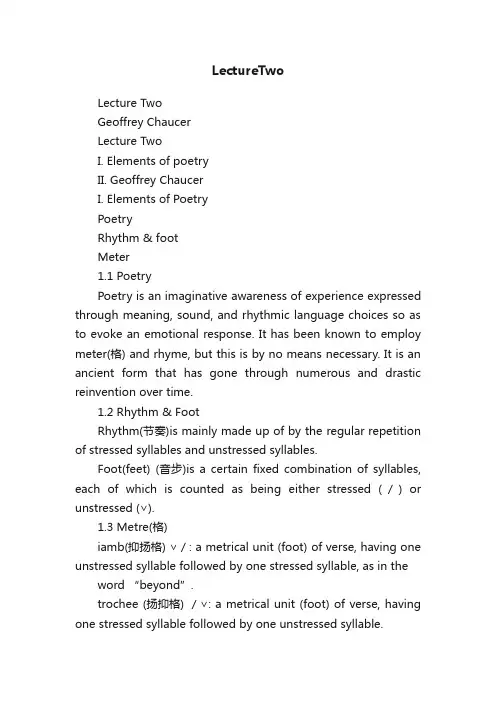
LectureTwoLecture TwoGeoffrey ChaucerLecture TwoI. Elements of poetryII. Geoffrey ChaucerI. Elements of PoetryPoetryRhythm & footMeter1.1 PoetryPoetry is an imaginative awareness of experience expressed through meaning, sound, and rhythmic language choices so as to evoke an emotional response. It has been known to employ meter(格) and rhyme, but this is by no means necessary. It is an ancient form that has gone through numerous and drastic reinvention over time.1.2 Rhythm & FootRhythm(节奏)is mainly made up of by the regular repetition of stressed syllables and unstressed syllables.Foot(feet) (音步)is a certain fixed combination of syllables, each of which is counted as being either stressed (/) or unstressed (∨).1.3 Metre(格)iamb(抑扬格) ∨/: a metrical unit (foot) of verse, having one unstressed syllable followed by one stressed syllable, as in the word “beyond”.trochee (扬抑格) /∨: a metrical unit (foot) of verse, having one stressed syllable followed by one unstressed syllable.anapaest (抑抑扬格) ∨∨/dactyl (扬抑抑格) /∨∨II. Geoffrey Chaucer(1340-1400)Life“The Canterbury Tales”Chaucer’s contribution to English literature2.1 Chaucer’s LifeHe was born in 1343 in London.He died in 1400 and was buried in Westminster Abbey, thus founding the “Poets Corner”.The founder of English poetry.2.2 “The Canterbury Tales”(1387-1400)It is Chaucer’s masterpiece and one of the monumental works in English literature.Outline of the StoryThe PrologueThe TalesOutline of the StoryOn a spring evening, the poet, moved by the passion for wandering, drops himself at the Tabard Inn at the south end of London Bridge. Here he meets 29 pilgrims ready for a journey of 60 miles on horseback to Canterbury.He joins this company. At the suggestion of the host of the inn, they agree to beguile the journey by story-telling. Each to tell 2 stories going and 2 returning. The best story-teller will be treated with a fine supper at the general expense at the end. The host is to be the judge of the contest.The Prologue(《总引》)The prologue provides a framework for the tales.It contains a group of vivid sketches of typical medieval figures.It provides a miniature of the English society of Chaucer’s time.The TalesEach of the narrator tells his tale in a peculiar manner, thus revealing his own views and character.The tales of the Knight, the Pardoner, the Nun’s Priest and the Wife of Bath, are generally regarded as the best of the whole collection.2.3 Chaucer’s Contributionto English LiteratureChaucer is regarded as the founder of English poetry and has been called “the founder of English realism.” He is the first great poet who wrote in the English language.He introduced from France the rhymed stanza of various types, especially the “heroic couplet” (英雄双韵体) to English poetry.His masterpiece “The Canterbury Tales” is one of the monumental works in English literature.《总引》碧蓝的天空腾起一轮红日,青春的太阳洒下万道金辉。
The Basic Elements of Appreciating English Poetry1.What is poetry?Poetry is the expression of Impassioned feeling in language.“Poetry is the spontaneous overflow of powerful feelings: it takes its origin from emotion recollected in tranquility.”“Poetry, in a general sense, may be defined to be the expression of the imagination.”Poetry is the rhythmical creation of beauty.Poetry is the image of man and nature.“诗言志,歌咏言。
” ---《虞书》“诗言志之所以也。
在心为志,发言为诗。
情动于中而行于言,言之不足,则嗟叹之;嗟叹之不足,故咏歌之;咏歌之不足,不知手之舞之,足之蹈之也。
情发于声;声成文,谓之音。
”---《诗·大序》“诗是由诗人对外界所引起的感觉,注入了思想与情感,而凝结了形象,终于被表现出来的一种‘完成’的艺术。
” ---艾青:《诗论》2.The Sound System of English Poetrya. The prosodic featuresProsody (韵律)---the study of the rhythm, pause, tempo, stress and pitch features of a language.Chinese poetry is syllable-timed, English poetry is stress-timed.Stress: The prosody of English poetry is realized by stress. One stressed syllable always comes together with one or more unstressed syllables.eg. Tiger, /tiger, /burning /brightIn the /forest /of the/ night,What im/mortal /hand or /eyeCould frame thy/ fearful /symme/try? ---W. BlakeLength: it can produce some rhetorical and artistic effect.eg. The curfew tolls the knell of parting day,The lowing herd wind slowly o’er the lea,The Ploughman homeward plods his weary way,And leaves the world to darkness and to me.---Thomas GrayLong vowels and diphthongs make the poem slow, emotional and solemn; short vowels quick, passionate, tense and exciting.Pause: it serves for the rhythm and musicality of poetry.b. Meter or measure (格律)poem---stanza/strophe---line/verse---foot---arsis + thesis;Meter or measure refers to the formation way of stressed andunstressed syllables.Four common meters:a) Iambus; the iambic foot (抑扬格)eg. She walks/ in beau/ty, like/ the nightOf cloud /less climes/ and star/ry skies;And all/ that’s best /of dark/ and brightMeet in /her as /pect and /her eyes. ---Byronb) Trochee; the trochaic foot(扬抑格)eg. Never /seek to/ tell thy/ love,Love that/ never/ told can/ be. ---Blake c) Dactyl; the dactylic foot (扬抑抑格)eg. Cannon to/ right of them,Cannon to/ left of them.Cannon in/ front of them,V olley’d and/ thunder’d. ---Tennysond) Anapaest; the anapestic foot(抑抑扬格)eg. Break,/ break, /break,On thy cold /grey stones,/ O sea!And I would /that my tongue/ could utterThe thought/ that arise /in me. ---Tennysonc) Other metersAmphibrach, the amphibrachic foot (抑扬抑格);Spondee, the spondaic foot(扬扬格);Pyrrhic, the pyrrhic foot (抑抑格);d) Actalectic foot (完整音步) and Cactalectic foot(不完整音步)eg. Rich the / treasure,Sweet the / pleasure. (actalectic foot)Tiger,/ tiger, /burning /bright,In the/ forest/ of the/ night. (cactalectic foot )e) Types of footmonometer(一音步)dimeter(二音步)trimeter(三音步)tetrameter(四音步)pentameter(五音步)hexameter(六音步)heptameter(七音步)octameter(八音步)We have iambic monometer, trochaic tetrameter, iambicpentameter, anapaestic trimeter, etc., when the number offoot and meter are taken together in a poem.C. RhymeWhen two or more words or phrases contain an identicalor similar vowel sound, usually stressed, and theconsonant sounds that follow the vowel sound areidentical and preceded by different consonants, a rhymeoccurs.It can roughly be divided into two types:internal rhyme and end rhymeInternal rhymea) alliteration: the repetition of initial identical consonant sounds or any vowel sounds in successive or closely associated syllables, esp. stressed syllables.eg. The fair breeze blew, the white foam flew,The furrow followed free.---ColeridgeI slip, I slide, I gloom, I glance,Among my skinning swallows.---Tennyson Whereat with blade, with bloody blameful blade,He bravely broached his boiling bloody breast.---Shakespeare “Consonant cluster” (辅音连缀)“internal or hidden alliteration” (暗头韵) as in“Here in the long unlovely street” (Tennyson)The Scian & the Teian muse,The hero’s harp, the love’s lute,Have found the fame your shores refuse.---Byron b) Assonance (腹韵/元音叠韵/半谐音):the repetition of similar or identical vowel sounds in a line ending with different consonant sounds.eg. Do not go gentle into that nightOld age should burn and rave at close of day.Rage, rage against the dying of the light.Though wise men at their end know dark is right,Because their words have forked no lightning theyDo not go gentle into that night.c) Consonance (假韵): the repetition of the ending consonant sounds with different preceding vowels of two or more words in a line.eg. At once a voice arose amongThe bleak twigs overheadIn a full-hearted evensongOf joy illimited.---HardyEnd rhyme: lines in a poem end in similar or identicalstressed syllables.a) Perfect rhymePerfect rhyme (in two or more words) occurs in the following three conditions:identical stressed vowel sounds (lie--high, stay--play);the same consonants after the identical stressed vowels (park--lark, fate-- late);different consonants preceding the stressed vowels (first– burst);follow—swallow (perfect rhyme)b) imperfect/ half rhyme: the stressed vowels in two or more words are the same, but the consonant sounds after and preceding are different.eg. fern—bird, faze—late, like—rightc) Masculine and feminine rhymeeg. Sometimes when I’m lonely,Don’t know why,Keep thinking I w on’t be lonelyBy and by.---Hughes The comrade of thy wanderings over Heaven,As then, when to outstrip thy skiey speedScarce seem’d a vision; I would ne’er have striven…---Shelley Rhyme scheme (韵式)a) Running rhyme scheme (连续韵)two neighbouring lines rhymed in aa bb cc dd:eg. Tiger, tiger, burning brightIn the forests of the night,What immortal hand or eyeCould frame thy fearful symmetry?In what distant deeps or skiesBurnt the fire of thine eyes?On what wings dare he aspire?What the hand dare seize the fire?b) Alternating rhyme scheme (交叉韵)rhymed every other line in a b a b c d c d:eg. Shall I compare thee to a summer’s day?Thou art more lovely and more temperate:Rough winds do shake the darling buds of May,And summer’s lease hath all too short a date:---Shakespearec) enclosing rhyme scheme (首尾韵)In a quatrain, the first and the last rhymed, and the second and the third rhymed in a b b a:eg. When you are old and gray and full of sleep,And nodding by the fire, take down this book,And slowly read, and dream of the soft lookYour eyes had once, and of their shadows deep;---W. B. YeatsD. Form of poetry ( stanzaic form)a) couplet: a stanza of two lines with similar end rhymes:eg. A little learning is a dangerous thing;Drink deep, or taste not the Pierian Spring.b) heroic couplet: a rhyming couplet of iambic pentameter:eg. O could I flow like thee, and make thy streamMy great example, as it is my theme:---DenhamThen share thy pain, allow that sad relief;Ah, more than share it, give me all thy grief.---Popec) Triplet / tercet: a unit or group of three lines, usu. rhymedeg. He clasps the crags with crooked hands;Close to the sun in lonely lands,Ringed with the azure world, he stands.The wrinkled sea beneath him crawls:He watches from his mountains walls,And like a thunderbolt he falls.---Tennyson d) quatrain: a stanza of four lines rhymed or unrhymed.eg. O my luve is like a red, red rose,That’s newly sprung in Jun e;O my luve is like the melodieThat’s sweetly play’d in tune.As fair art thou, my bonie lass,So deep in luve am I;And I will luve thee still, my dear,Till a’ the seas gang dry.---Burnse) Sonnet: a fixed verse form of Italian origin consisting of14 lines that are characteristically in iambic pentameter:The Petrarchan / Italian sonnet (Francesco Petrarch):two parts: octave, asking question, presenting a problem,or expressing an emotional tension rhyming abba abba;while the sestet, solving the problem rhyming cde cde,cde cde, or cd cd cd.Shakespearean / English sonnet:arranged usually into three quatrains and a couplet,rhyming abab cdcd efef gg. The first quatrain introducesa subject, the second expands, and once more in the third,and concludes in the couplet.Spenserian sonnet: three quatrains and a couplet rhymingabab bcbc cdcd ee;Miltonic sonnet: simply an ltalian sonnet that eliminates thepause between the octave and sestet.f) Blank verse: the unrhymed iambic pentametereg. To be, or not to be: that is the question:Whe ther ’tis nobler in the mind to sufferThe slings and arrows of outrageous fortune,Or to take arms against a sea of troubles,And by opposing end them? To die: to sleep;---Shakespeareg) Free verse: poetry that is based on irregular rhythmiccadence of the recurrence, with variations, of phrases,images and syntactical patterns rather than theconventional use of meter.eg. DaysWhat are days for?Days are where we live.They come, they wake usTime and time over.They are to be happy inWhere can we live but days?Ah, solving that questionBring the priest and doctorIn their long coatsRunning over the fields.---Philip Larkin3.The semantic system of English poetrya. The meaning of poetryPoetry is “the one permissible way of saying one t hingand meaning another”. (Frost)The meaning of a poem usually consists of three levels,that is, the literal (the lowest), the sensory (the medium)and the emotional (the highest).b. Image---the soul of the meaning in poetrya) Definition: “language that evokes a physical sensationproduced by one or more of the five senses--- sight,hearing, taste, touch and smell.” (Kirszner and Mandell)A literal and concrete representation of a sensoryexperience or of an object that can be known by one ormore of the senses.b) Types of imagesIn terms of senses:visual image (视觉意象)auditory image(听觉意象)olfactory image(嗅觉意象)tactile image (触觉意象)gustatory image (味觉意象)kinaesthetic image (动觉意象)eg. Spring, the sweet spring, is the year’s pleasant king,Then blooms each thing, then maids dance in a ring,Cold doth not sting, the pretty birds do sing:Cuckoo, jug-jug, pu-we, to-witta-woo!---Thomas Nashe In terms of the relation between the image and the object:Literal (字面意象) and figurative image (修辞意象)The former refers to the one that involves no necessarychange or extension in the obvious meaning of the words;or the one in which the words call up a sensoryrepresentation of the literal object or sensation.The latter is the one that involves a turn on the literalmeaning of the words.eg. Let us walk in the white snowIn a soundless space;With footsteps quiet and slow,At a tranquil pace,Under veils of white lace.---Elinor WylieIn terms of the readers: fixed and free image(稳定意象和自由意象)By fixed or tied image, it is the one so employed that itsmeaning and associational value is the same ornearly the same for all readers.By free image, it is the one not so fixed by the context thatits possible meanings or associational values are limited, itis therefore, capable of having various meanings or valuesfor various people.eg. SnakeI saw a young snake glideOut of the mottled shadeAnd hang limp on a stone:A thin mouth, and a tongueStayed, in the still air.It turned; it drew away;Its shadow bent in half;It quickened and was gone.I felt my slow blood warm.I longed to be that thing,The pure, sensuous form.And I may be, some time. ---Theodore Roethkec) The function of image:to stimulate readers’ senses;to activate readers’ sensory and emotional experience;to involve the readers in the creation of poetry with personal and emotional experience; to strike a responsive chord in the hearts of readers;eg. FogThe fog comeson little cat feet.It sits lookingover harbor and cityon silent haunchesand then moves on.---Carl Sandbergeg. Fire and iceSome say the world will end in fire,Some say in ice.From what I’ve tasted of desireI hold with those who favor fire.But if it had to perish twice,I think I know enough of hateTo say that for destruction iceIs also greatAnd would suffice. ---R. FrostC. The means of expressing meaninga) Phonetic devicesonomatopoeiaA widow birdeg. A widow bird was mourning for her loveUpon a wintry bough;The frozen wind crept on above,The freezing stream belowThere was no leaf upon the forest bare,No flower upon the ground,And little motion in the airExcept the mill-wheel’s sound. P. B. Shelley Puneg.The little black thing among the snowCrying “’weep, ’weep” in notes of woe!b) figures of speechA. comparison: metaphor; simile (tenor 本体, vehicle 喻体)B. conceitC. personificationD. metonymy (换喻)E. apostropheF. synaesthesia (“通感”或“联觉”)G. symbolismH. hyperboleI. Allusion (典故)c) Deviation (变异):the digression from the normal way ofexpressionsLexical deviation (self-made words)精品文档Grammatical deviation (slang, vernacular) Deviation of registersDeviation of cultural subjects精品文档。
《英美诗歌欣赏》课程教学大纲The Course Syllabus of a Course of British and AmericanPoetry一、课程基本信息(Basic Course Information)课程代码:16221501Course code: 16221501课程名称:英美诗歌欣赏Course name: A Course of British and American Poetry课程类别:通识选修课Course type: Liberal Course学时:16Periods: 16学分:1Credits: 1适用对象:全校各专业学生Target students: Undergraduates of all majors考核方式:考查Assessment: Examination/Paper先修课程:大学英语I-IIPreparatory courses: Course English I-II二、课程简介(Brief Course Introduction)本课程为通识选修课,于每个学期开设,是提高全校学生人文素养的一门选修课程。
本课程介绍英美诗歌的主要类型:叙事诗歌、抒情诗歌以及戏剧性诗歌。
着重讲述抒情诗歌的主要形式:十四行、颂歌体、歌谣体以及挽歌体;介绍英语诗歌的要素:音律以及押韵,遣词造句,修辞以及意象,象征以及寓言等知识,使学生能够比较系统了解英美诗歌的特点,能够初步运用英美诗歌知识进行简单的赏析。
A Course of British and American Poetry is a liberal course for students of the all majors, aiming to provide the general knowledge of British and American poetry, deepen the understanding of English and American culture. It introduces the major types of English poetry: narrative poetry, lyric poetry and dramatic poetry, elaborates on lyric poetry, specifically introducing sonnet, ode, song and elegy, focuses on the poetic elements: musicality of the poetry (sound, rhythm and meter), image, figures of speech, voice, dictionand syntax, symbol and allegory. Thus the students could systematically know about the features of English poetry, basically enabling them to appreciate an English poem.三、课程性质与教学目的本课程旨在通过一学期的阅读、讲授及讨论,使学生对英美诗歌的类型、要素和主题有总体的了解,通晓英美诗歌的名篇和名家,并适当和中国诗歌作比较,并在掌握英美诗歌常识的基础上,进一步提高文化修养,理解中西诗歌的相异,加深对英语语言的文化内涵的认识,进一步深化对英美文化的洞察力。